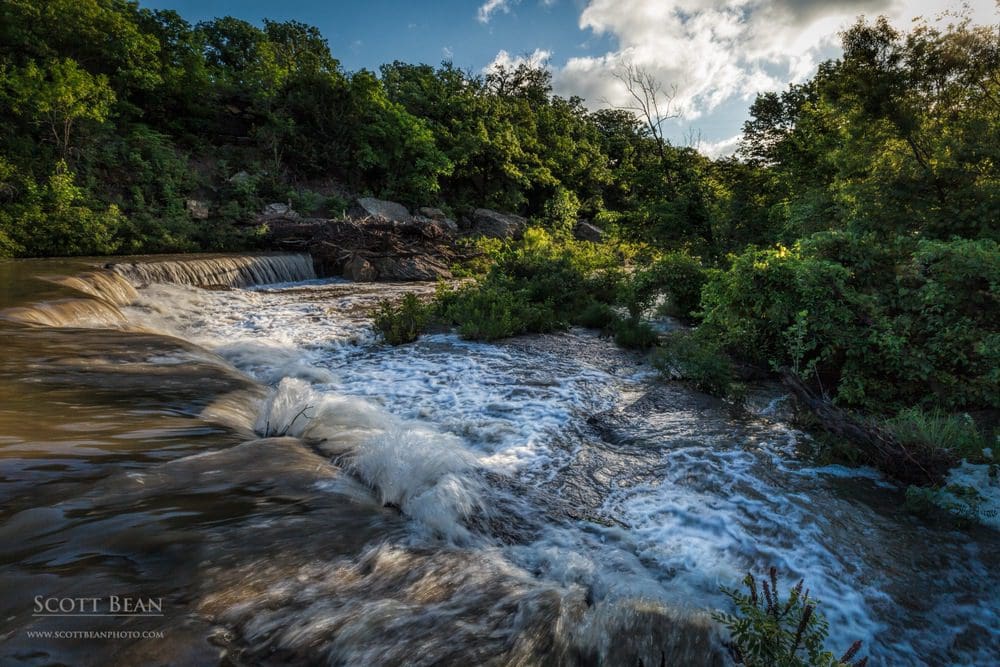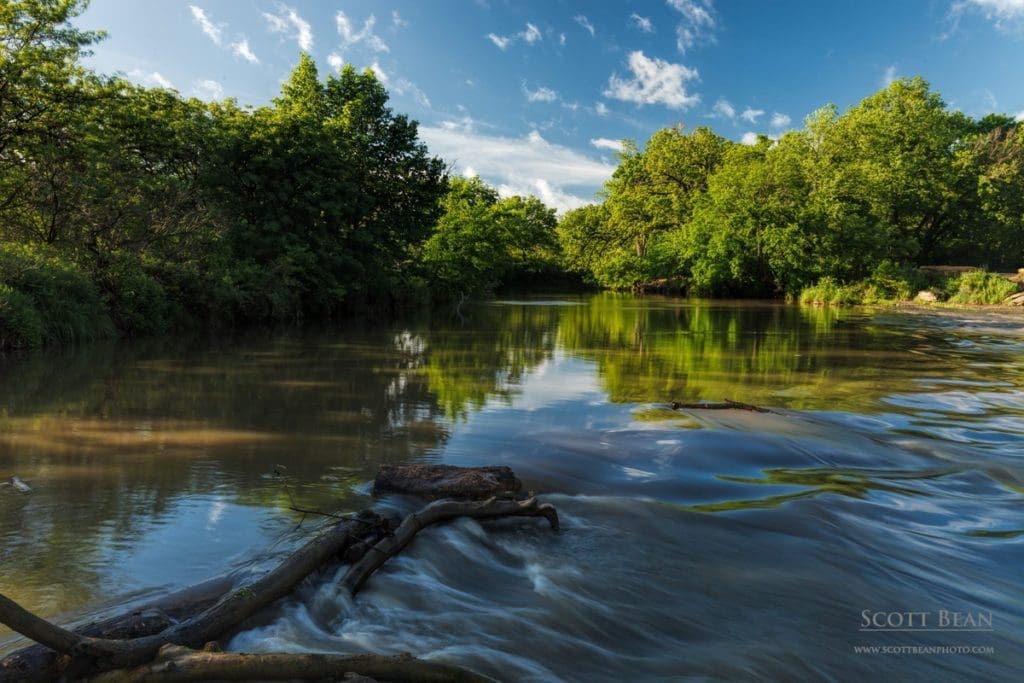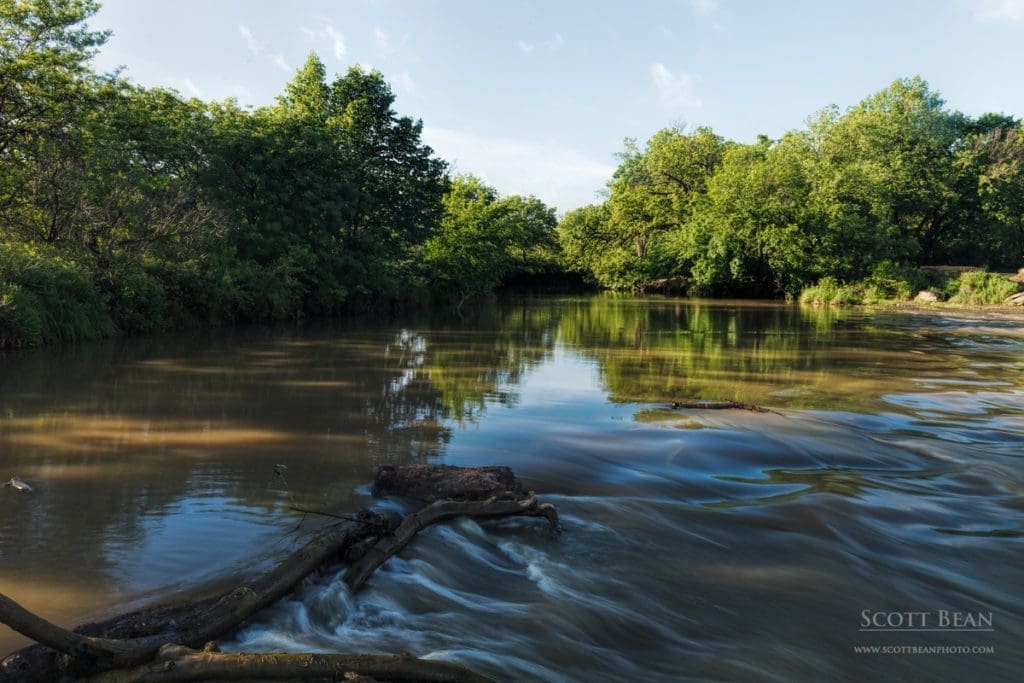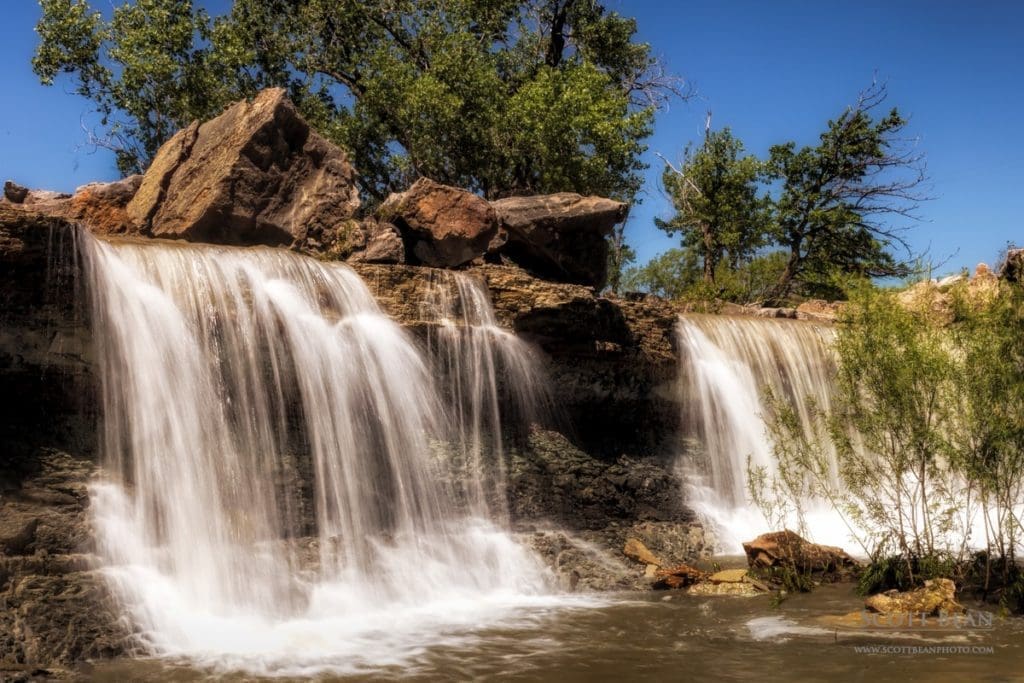With the recent heavy rains (and then more rains and then more rains, etc.) the area lakes and rivers are running full. All this water, of course, also means that many of the waterfalls in Kansas are flowing very strongly (and that I’ve spent more time mowing the lawn already this spring than I did all of last summer).
A couple of weeks ago, Manhattan received a downpour which caused some flooding in parts of town (fortunately for me, not my part). I thought that the nearby waterfall at Pillsbury Crossing would really be running but a quick trip out there revealed surprisingly very little water flowing in Deep Creek. After another week of rain, this time more widespread across the area, I decided to visit Pillsbury Crossing again and see if there was any change.

This time there was most definitely a lot of water running over the falls! Parts of the trail below the falls were under water and I didn’t really feel like fighting my way up to the falls from below so I decided to just photograph from an easily accessible area above the falls. I wasn’t really expecting the photos from this vantage point to turn out that well, but I really liked them. The clouds in the sky created some visual interest and the textures of the water going over the falls were also interesting. I used a sunny white balance which kept a blue tint in the water in the shade which added a nice bit of color in that section of the photo. The sound of water (even when loud) is always so peaceful.
I set my camera for a slow shutter speed (high f-stop, low ISO) to blur the water. It was pretty bright on this particular morning so I also used a circular polarizer filter. This filter helped darken the sky a bit (the classic use of a polarizer filter) but also helped me achieve slower shutter speeds. Polarizers block out ~2 stops of light so I’ll often use one basically as a 2 stop neutral density filter…regardless of the effect of the polarizer has on the colors and contrast of the scene.

As we were leaving I decided to make some photos of Deep Creek above the water falls. There were some beautiful reflections of the trees along the shore and some nice ripples where the water was flowing down towards the falls. For this photo, I also used my polarizer filter, not so much in this case for the slow shutter speed, but to darken the sky. Polarizer filters can also improve the color saturation of vegetation and block reflections off the surface of water…both of which really brought out the trees and their reflection along the shore.

For comparison, this next photo was made with my polarizer adjusted to its minimum effect. To use a polarizer filter, you attach it to your lens and then rotate the outer ring of the filter. As you rotate the outer ring, the polarization changes (you still lose 2 stops of light no matter what effect you adjust the filter for). The strength of the effect you will get from a polarizer depends on your angle to the sun, so results will vary. I don’t use many filters anymore, but a polarizer is one that I won’t stop using anytime soon.

Shortly after leaving Pillsbury Crossing, a friend contacted me and invited me down to photograph the waterfalls at Lake Kahola which is south of Council Grove Kansas. I’ve visited the waterfalls at Lake Kahola before (with permission, this is private property) but on my previous visits the water wasn’t flowing anything at all like it was on this trip. This area has all been created by water flowing over the years…it is really impressive what water can do (probably a good lesson there about the power of persistence).

After photographing all the main waterfalls from above, I made my way down below the falls and made a few photographs there. Again I was using my polarizing filter, to both darken the sky and help get slower shutter speeds. Polarization can really darken a sky in the right conditions and I think I used too strong of an effect in this case. If I would have been paying more attention at this point, I would have probably backed off the strength a bit. I was pretty distracted though by the waterfalls, it was really fun to see these falls with so much water coming over and I am very grateful for the invitation to come down to visit them.
Since visiting Pillsbury and Kahola falls I’ve had the opportunity to photograph a few others. I’ll have photos of those on the blog soon. If you are interested in learning more about Kansas waterfalls make sure you check out the Kansas Waterfalls page on www.kansastravel.org. It is a great resource and I’ve gotten a lot of use out of it (thank you Keith!).
With the continued rain, the waterfalls will be running for awhile I think. Water in all its forms is beautiful to photograph (and just sit and relax with), but it can be dangerous in some cases. Make sure and stay safe if photographing around water that is really running strong. Also keep an eye out for poison ivy when tromping around the waterfalls, I can tell you from experience that poison ivy and waterfalls seem to go hand in hand!
If you would like to see more of my waterfall photographs, please visit my Energy of Water Gallery and if you would like to be notified when I make new blog posts, have sales and other announcements, please sign up for my email list.
Thanks for stopping by!
